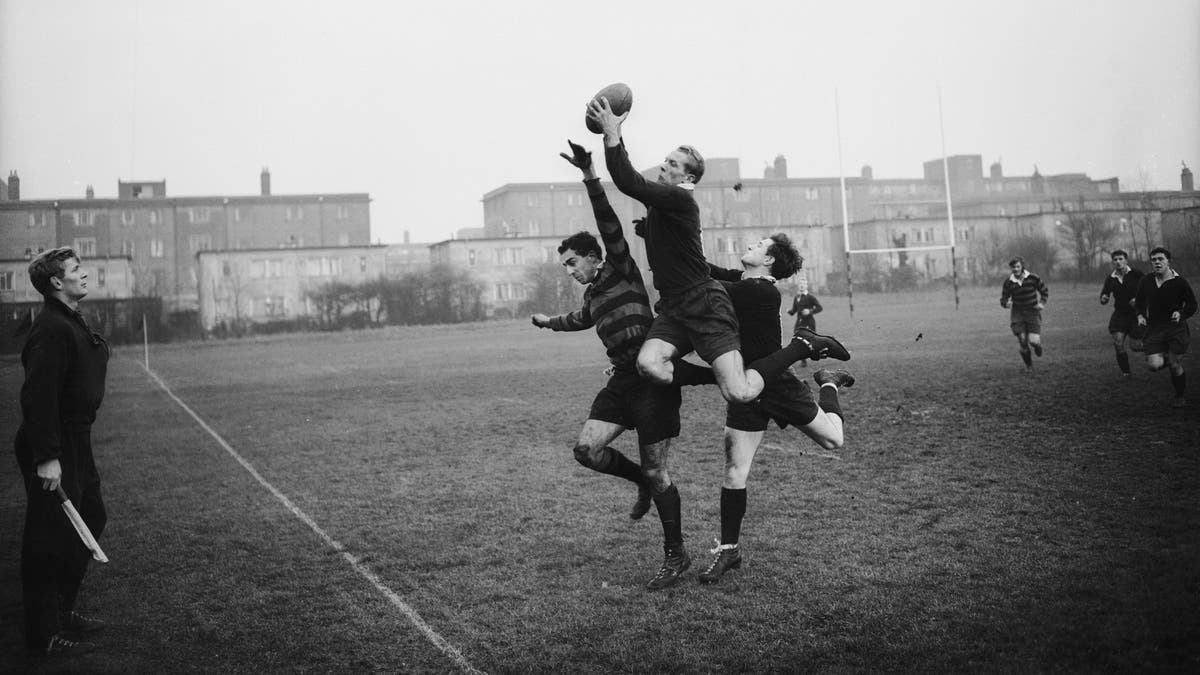
American Rhodes student and Oxford rugby blue Peter Dawkins catches the ball during a match against Blackheath, 14th November 1959. (2004 Getty Images)
Pete Dawkins has amassed one of the most impressive lists of leadership credentials I have ever seen.
From the time he was a young boy, Dawkins was determined to be a winner. When he was eleven years old, he was diagnosed with polio — a disease that often left its victims paralyzed. In the 1940’s and 50’s, before Jonas Salk introduced his lifesaving polio vaccine in 1955, the highly contagious and occasionally fatal disease raged across the United States in frighteningly epidemic proportions.
Determined to survive, Dawkins underwent months of grueling physical therapy to regain use of his limbs, eventually beating the disease. From that victorious moment onward, Dawkins was unstoppable in his pursuit of personal excellence, rising to meet one extraordinary challenge after another.
No organization is better than the people who run it. If you want to be a great leader, put people first. This lesson is so simple it’s easy to overlook.
After defeating polio, Dawkins won a scholarship to Cranbrook Kingswood School, a prestigious private school outside Detroit. He excelled academically and also on the playing field as both captain of the baseball team and one of the league’s leading quarterbacks.
Dawkins turned down the chance to attend Yale University, opting instead for the U.S. Military Academy at West Point. There, he played halfback and was captain of the football team, assistant captain of the hockey team, brigade commander, class president, and was in the top five percent of his class academically.
His achievements were so outstanding and his future held such immense promise that he was profiled in Life Magazine and Readers Digest.
In 1958, Dawkins won two of college football’s most prestigious awards – the Heisman Trophy and the Maxwell Award – putting him in the same company as gridiron greats like Tony Dorsett, Marcus Allen, Vinnie Testaverde, Roger Staubach and Paul Hornung.
Upon graduating with honors from West Point, he attended Oxford University on a Rhodes Scholarship. After earning a degree in philosophy, politics, and economics from Oxford, Dawkins completed Infantry School and Ranger School and assumed duty with the 82nd Airborne Division where he commanded a Rifle Company.
He served as senior advisor to the Vietnamese 1st Airborne Battalion in Vietnam. He won two Bronze Stars for valor, and was a battalion commander in Korea, a brigade commander at Fort Orb, and was the Division Chief of Staff in the 101st Airborne Division.
After serving twenty-four years in the Army, Dawkins retired as a Brigadier General and launched his career in the private sector with a partnership at Lehman Brothers, a global investment banking company. He then served as vice-chair of Bain and Company, a business and strategy consulting firm; CEO for Primerica, a financial services company; and CEO of Diversified Distribution Services for The Travelers Group before becoming vice chairman of Citigroup.
Throughout the process of achieving these noteworthy goals, Pete Dawkins gleaned an immense body of knowledge about what it takes to be a successful leader. But there is one simple thing he claims is the key to his leadership success: he keeps a laser-like focus on his people.
Whether he was leading an airborne company parachuting into enemy territory, a corporate board trying to widen the company’s profit margin, or a football team striving for a perfect winning record – his people always occupied the center of his attention.
“People skills are simple but essential. In any team or organization, people need to believe that their leader knows them, understands them and cares about them,” Dawkins explained. “That doesn’t mean that you’re their buddy; it doesn’t mean that you aren’t tough. I don’t think people want their leader to be their buddy – they want to respect their leader. Of course you have to have skill competence; you have to know what you’re doing. But you also have to have people competence.”
Dawkins says to have ‘people competence’ is simply to have regard for the individuals who are part of your team or organization. He knows the names of all the nearly 20 associates in his office, and he greets them warmly whenever he sees them. He knows the names of all the people who clean his offices at night.
“The folks who work closely with me, I know if they’re married, unmarried, who their kids are, if they’ve had an accident or been sick, what they do for fun,” said Dawkins. “You don’t learn those things as a mechanical checklist, you just do it naturally. In doing so, you build a reservoir of trust and regard where people understand that you care about them not just because of what they can do for you or for the organization, but because they are human beings. That is much more powerful than people seem to regard it.”
No organization is better than the people who run it. If you want to be a great leader, put people first. This lesson is so simple it’s easy to overlook.
Why is it that most managers identify their business by the product it creates or the service it provides? The fact is that you are in the people business – in the business of hiring, training, and managing people to deliver the product or service that you provide.
If the people are the engine of your success, then to be a great leader you must be in the driver’s seat with your eyes focused laser-like on the team of people around you.
